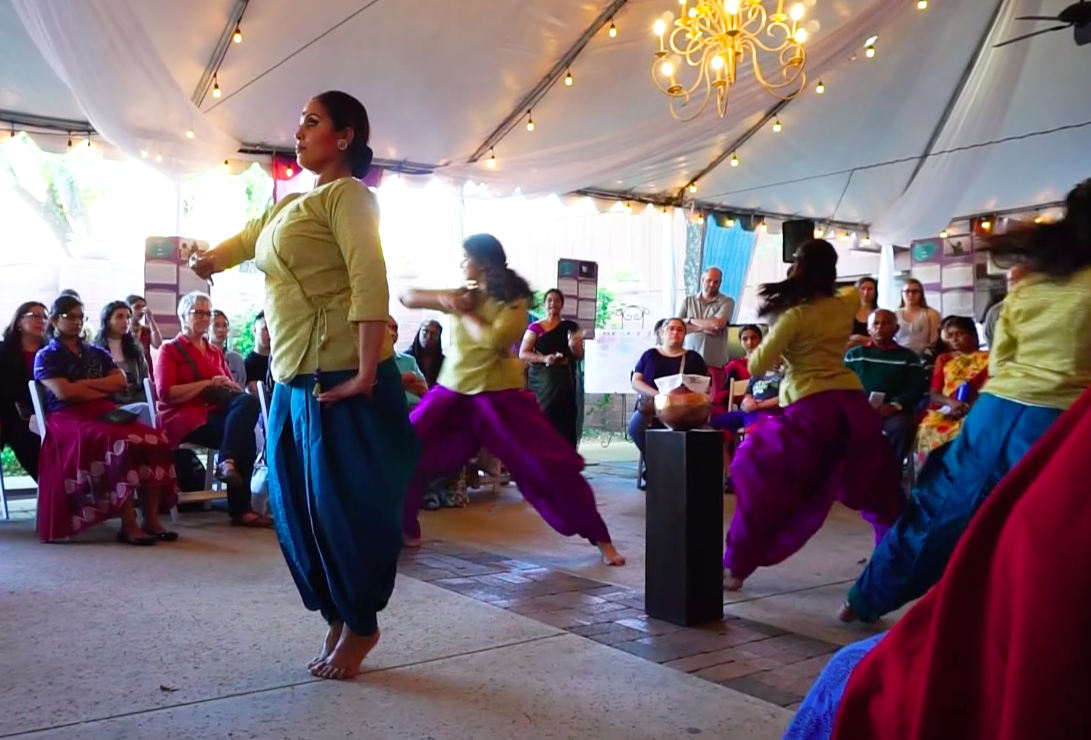Sumana Sen Mandala, director of Dansense – Nrtyabodha makes us look twice (or three times) at classical Indian dance forms Bharatanatyam and Bharata Nrityam. After all, this is the American Southwest – not a land typically associated with ancient texts as India is. So how could this dance form thrive or blossom here in Phoenix beyond a small interested group? Sumana, a visionary dancer with extraordinary imagination is the answer!
Sumana has taught classical Indian dance in Phoenix since 2015 and in the US since 2000. It is a form with a long tradition and clear vocabulary. As a dancer and choreographer, she wanted to not only bring this form to Arizona, but to meaningfully join it to local contemporary life. Because classical Indian dance is so steeped in tradition, there is concern for maintaining its pure authentic state. But Sumana (a scholar herself) knew the ancient texts reflected flexibility within the classical Indian dance form itself. The tension between purity and flexibility (as we’ve seen over and over in dance) lives in classical Indian dance as well. In Sumana’s words: “the connection between what we live and what we dance is very hard to find or see.” A desire to discover that elusive connection has driven her work here in Phoenix.
 She worked with community members at Arizona Coalition to End Domestic and Sexual Violence. The project is called Look into my Voice – Hear my Dance (LVHD). Sumana’s Indian dance students worked together with survivors of violence. Stories were exchanged. The dancers took the survivors’ stories and translated them into Bharata Nrityam vocabulary. A dialogue ensued about the trueness and accuracy of the dance depiction and a deeper analysis of gesture and meaning ensued. “Success of a dancer,” says Sumana “is based in how well dancers communicate their ideas.” This collaboration supported the strength and clarity of those ideas. The participants spoke of the project as transformative! It resulted in an embodied understanding of lived stories by both survivors of violence and dancers. It resulted in an iteration of Bharata Nrityam that connected deeply with Arizona citizens.
She worked with community members at Arizona Coalition to End Domestic and Sexual Violence. The project is called Look into my Voice – Hear my Dance (LVHD). Sumana’s Indian dance students worked together with survivors of violence. Stories were exchanged. The dancers took the survivors’ stories and translated them into Bharata Nrityam vocabulary. A dialogue ensued about the trueness and accuracy of the dance depiction and a deeper analysis of gesture and meaning ensued. “Success of a dancer,” says Sumana “is based in how well dancers communicate their ideas.” This collaboration supported the strength and clarity of those ideas. The participants spoke of the project as transformative! It resulted in an embodied understanding of lived stories by both survivors of violence and dancers. It resulted in an iteration of Bharata Nrityam that connected deeply with Arizona citizens.
Embedded in Indian classical dance (and texts) is cognizance of the connection between the physical, emotional, intellectual and spiritual elements; each connecting to the other. Classical Indian dance vocabulary is a thread that weaves them together. The ideal sought is one of integration and dance is a practice that helps propel it. Sumana instinctively understood the powerful possibility that lived in Indian dance and found a way to join its wisdom with the wisdom that lived in the human stories of women and men. In our current political, social and cultural circumstances, a project that places human connection and cultural literacy at its core could not be more critical and timely!
If you would like more information on this program please contact Sumana at: moc.liamgnull@esnesnad or through her website dansense.org
Author: Dr. Susan Bendix is a local dance artist-entrepreneur, teacher and recipient of the 2019 Phoenix Mayor’s Arts Award in dance. She runs Think-Motion, a business featuring thoughtful, movement based programming. Dr. Bendix is an Arizona Dance Coalition director.
If you’d like to JOIN ADC, membership is for individuals, organizations and venues/presenters affiliated with dance.
SUBSCRIBE to receive our news and announcements.
ADC – “creating connections” since 2006. Learn more about ADC here.

